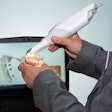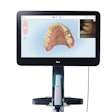How precise are digital intraoral scanners when used in a clinical setting?
A team of researchers from University Medical Center Freiburg in Germany attempted to find out in a new study in the American Journal of Orthodontics & Dentofacial Orthopedics (September 2013, Vol. 144:3, pp. 471-478).
Using the iTero (Align Technology), the researchers performed 10 full-arch intraoral scans on one patient, plus conventional impressions with a polyether impression material (Impregum Penta, 3M ESPE). Stone cast models manufactured from the impressions were digitized 10 times with an extraoral scanner (D250, 3Shape) and 10 times with the iTero. Virtual models provided by each method were roughly aligned, and the model edges were trimmed with cutting planes to create common borders, the researchers explained.
They then performed a second model alignment along the closest distances of the surfaces and compared deviations between the corresponding models to assess precision. Repeated intraoral scanning was evaluated in group 1, repeated extraoral model scanning with the iTero was assessed in group 2, and repeated model scanning with the D250 was assessed in group 3.
They found the greatest deviations, and therefore the lowest precision, in group 1, with mean deviations of 50 µm, median deviations of 37 µm, and root mean square errors of 73 µm. Group 2 showed a higher precision, with mean deviations of 25 µm, median deviations of 18 µm, and root mean square errors of 51 µm. Scanning with the D250 had the highest precision, with mean deviations of 10 µm, median deviations of 5 µm, and root mean square errors of 20 µm.
"Intraoral and extraoral scanning with the iTero resulted in deviations at the facial surfaces of the anterior teeth and the buccal molar surfaces," the study authors wrote. "Intraoral scanning with the iTero is less accurate than model scanning with the iTero, suggesting that the intraoral conditions (saliva, limited spacing) contribute to the inaccuracy of a scan."



















